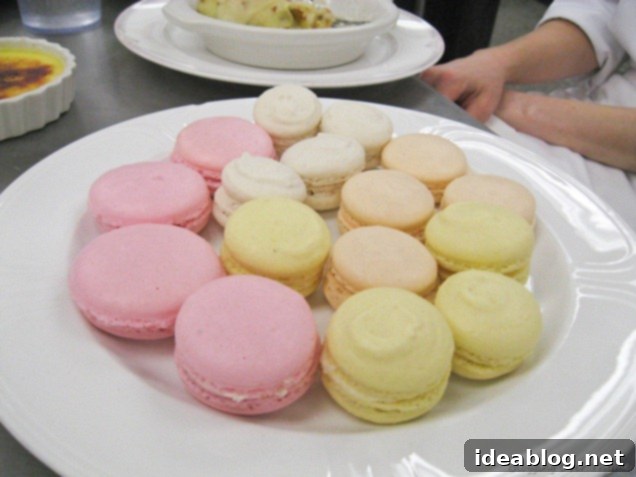Culinary School Chronicles: Mastering French Classics & Advanced Kitchen Techniques
Yesterday marked another intensely dynamic day in the culinary school kitchen. Stepping into the classroom, I was immediately greeted by a whiteboard teeming with the day’s ambitious menu – a sight that always evokes a mix of excitement for the new challenges ahead and a touch of intimidation at the sheer volume of dishes we were expected to master.
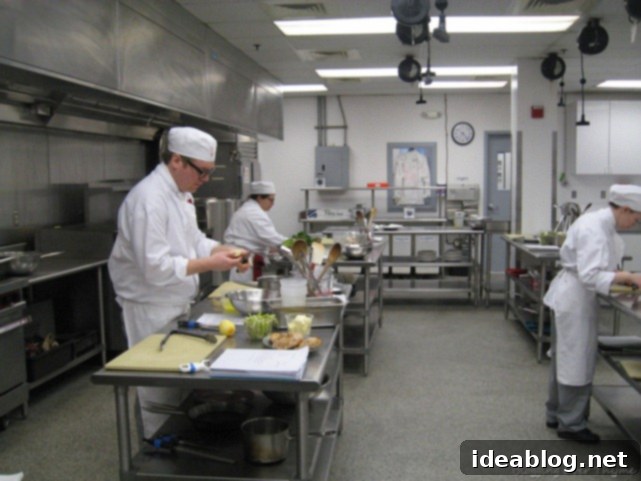
The Day’s Extensive French Menu:
LE CRÊPE DE VOLAILLE AU GRATIN (Chicken Crêpes Gratin)
LE FILET DE FLET POCHÉ (Poached Filet of Flat Fish)
LES ASPERGES À L’ANGLAISE (Steamed Asparagus)
LA SAUCE HOLLANDAISE (Hollandaise Sauce – we meet again!)
LES POMMES TOURNÉES À L’ANGLAISE (Boiled Tournéed Potatoes)
LA CRÈME BRÛLÉE
This demanding menu was designed to immerse us in a multitude of critical new techniques. We delved into the intricacies of tourneeing, an exceptionally difficult knife skill essential for shaping vegetables, and learned the precise art of filleting a whole flat fish. Additionally, we mastered the use of handheld torchers to achieve the perfect caramelized crust on our crème brûlées. It was an ambitious undertaking, requiring us to absorb a vast amount of information and practical skills within a single, intense day.
The Art of Filleting Flat Fish
Our morning demonstration began with our chef meticulously showcasing the technique for filleting a flat fish. In our case, it was a substantial flounder, but the method applies uniformly to all flat fish species, including the impressive halibut, which is the largest of its kind. Understanding the anatomy and employing the correct knife work are crucial for maximizing yield and presentation.
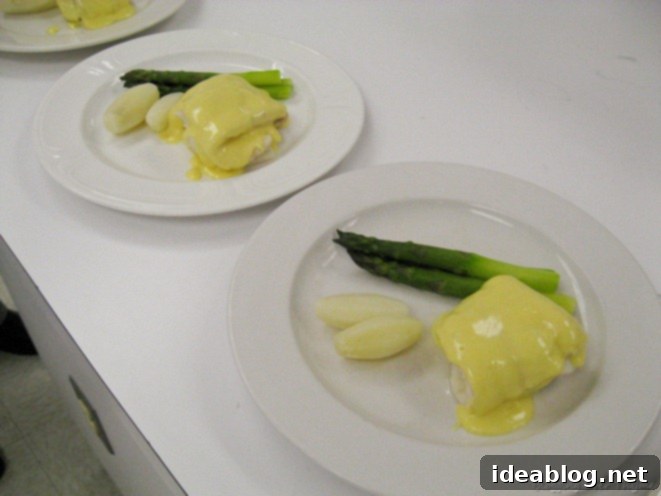
The Chef’s Demo Plates – trust me, my tournéed potatoes did not look that good!
A valuable piece of wisdom we gained relates to fish storage: always store fish in a manner that mimics its natural swimming posture. This means flat fish should be stored on their bellies, while round fish are best kept upright on ice. When purchasing whole fish, there are distinct characteristics to look for that guarantee its freshness and quality:
- Firm Flesh: The flesh should be firm to the touch with no soft spots or indentations, indicating it has been handled properly and stored at the correct temperature.
- Clear, Firm Eyes: Fresh fish will have eyes that are firm, round, and crystal clear. Avoid fish with sunken, cloudy eyes (resembling cataracts) or red rims, as these are strong indicators of age.
- Bright Red Gills: Gently lift the gill plate and examine the gills; they should be a vibrant, bright red, signifying recent blood flow. Brown or dark gills suggest the fish is past its prime.
- Salty Sea Aroma: The fish should possess a clean, oceanic scent reminiscent of salty sea water, not a strong, unpleasant “fishy” odor. A strong fishy smell is a definitive sign of spoilage.
The filleting process itself involves using a flexible boning knife to carefully cut along the spine, navigate around the head and belly, and finally, separate the tail. With precision, the knife is then used to remove the fillets from both sides of the fish. This technique, while challenging to articulate in words, requires significant practice to master. Perhaps once I achieve true competence, I can create a video demonstration of the process!
Once filleted, the delicate fish was destined for poaching. We gently cooked it in a flavorful liquid composed of equal parts whole milk and water, seasoned with aromatic bay leaf, fresh thyme, and robust peppercorns. This perfectly poached fish was then elegantly topped with a NAPE (just enough to lightly coat the surface) of our freshly prepared Hollandaise Sauce. Yes, Hollandaise made yet again! I’m delighted to report that this time, my Hollandaise turned out considerably better, both in terms of seasoning and, crucially, it did not break. It appears Hollandaise and I are finally becoming fast friends.
Accompanying our poached fish, we served simple yet elegant asparagus and the notorious TOURNÉED potatoes, as depicted in the chef’s demonstration photo. Tourneeing, I swear, is going to be the ultimate test of my patience and knife skills. It’s an incredibly meticulous technique that demands transforming a humble vegetable into an equal, seven-sided football shape with perfectly flat ends. The difficulty is immense, and the pressure mounts knowing it will undoubtedly be a key component of our practical exam next week!
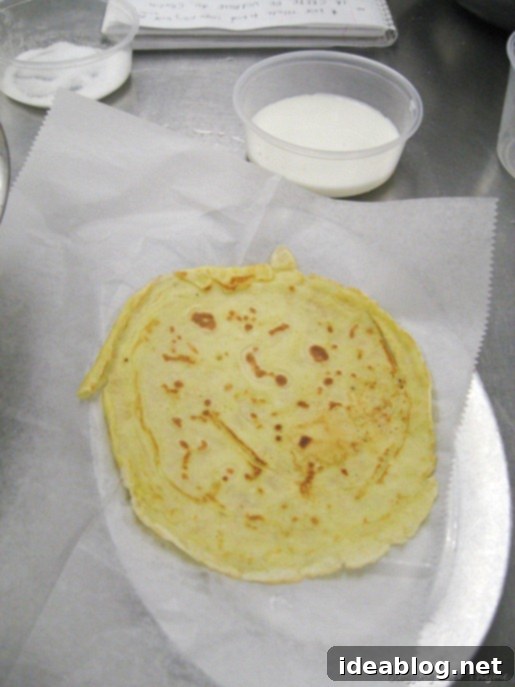
Crafting Chicken Crêpes Gratin
In addition to our time-consuming fish dish, we also tackled the creation of LA CRÊPE DE VOLAILLE AU GRATIN, which translates to delicious stuffed chicken crêpes. Naturally, this meant we first had to prepare fresh crêpe batter and meticulously cook each crêpe. This part of the day was thoroughly enjoyable, and I was pleased that all of my crêpes turned out perfectly, exhibiting that desirable thinness and flexibility.
For the filling, we utilized leftover roasted chicken leg meat, which we finely shredded and combined with sautéed mushrooms and fresh spinach. This savory mixture was then bound together with a rich velouté sauce – another classic French mother sauce. Velouté, essentially a roux (butter and flour cooked together) thickened with stock, was elevated with the addition of both Gruyère and Parmesan cheeses for extra depth of flavor. This exquisite filling was carefully spooned into our freshly made crêpes. Once rolled, they were topped with more velouté sauce and a generous sprinkle of cheese, then baked in the oven until golden brown and bubbling.
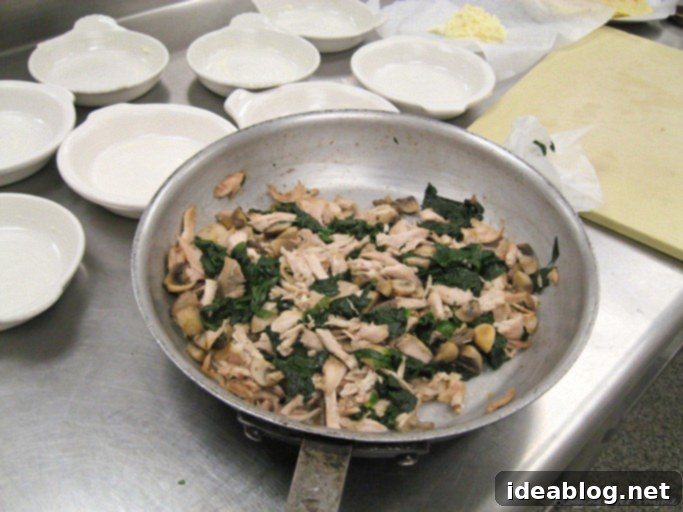
The chicken crêpes gratin proved to be incredibly tasty, though due to the frantic rush to get everything served on time, they didn’t quite achieve the deep, golden-brown crust we had hoped for. Nevertheless, the flavors were harmonious and satisfying.
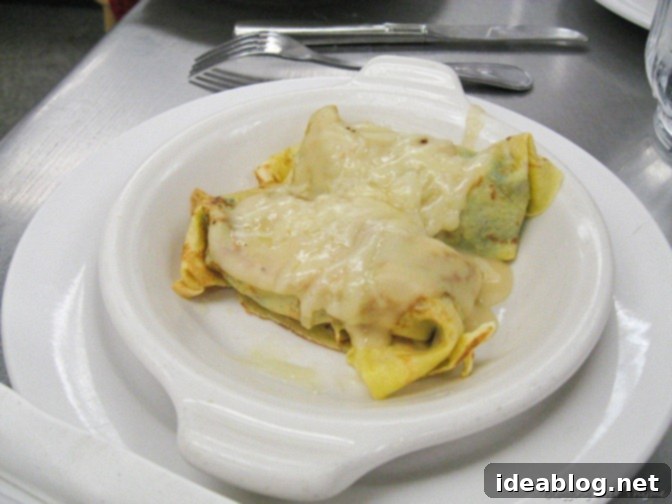
The Sweet Finale: Perfecting Crème Brûlée
And, of course, no extensive French menu would be complete without a dessert. Desserts are an integral part of our curriculum’s menu format, meaning we will always have a sweet creation on our daily task list, and they are progressively designed to become more challenging as we advance through the program.
Today’s sweet triumph was the elegant CRÈME BRÛLÉE, a beloved cousin of the equally classic crème caramel. While owning a torch to caramelize the sugar is essential for the finishing touch, the actual preparation of the crème brûlée custard is surprisingly straightforward. We crafted a quick, rich custard base, infusing it with the delightful aromas of vanilla bean and fragrant orange peel. The custards were then baked gently in a water bath – a crucial technique for all custards to ensure even cooking at a low temperature and prevent curdling. After baking, they were chilled thoroughly in the refrigerator. Just before serving, a layer of granulated sugar was sprinkled evenly over the top and then expertly torched, creating that signature, crisp, glassy sugar shell that defines a perfect crème brûlée.
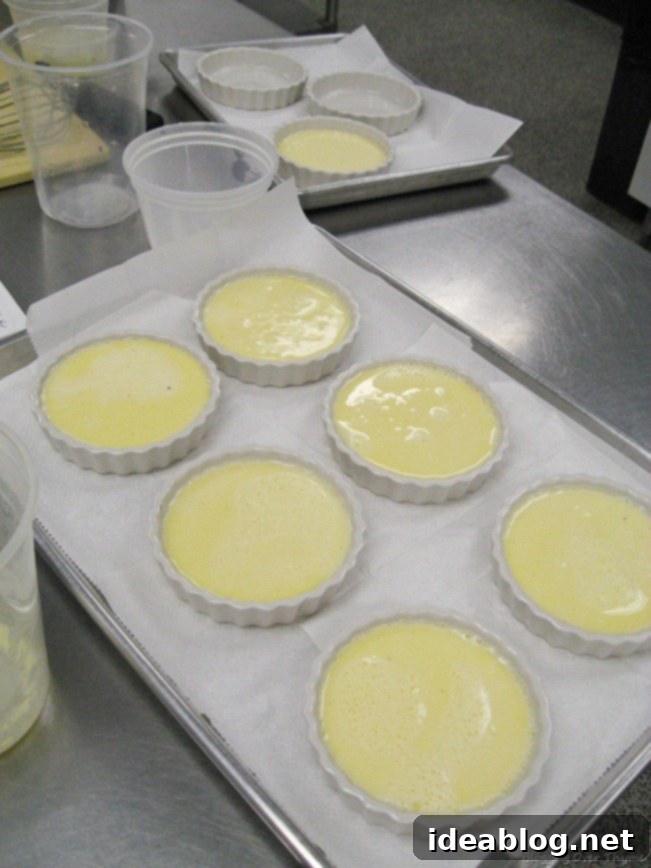
An intriguing fact we uncovered this week while making various custards relates to the design of the traditional ridged, shallow ramekins used for crème brûlée and crème caramel. These ridges are not merely decorative; they serve a specific functional purpose. The increased surface area provided by the ridges allows for more efficient heat penetration from the oven, ensuring the custard bakes evenly. Furthermore, the shallow depth of the ramekin guarantees the ideal ratio of the crisp, burnt sugar caramel to the smooth, sweet custard in every spoonful. It’s a testament to the thoughtful design behind classic culinary tools.
This crème brûlée was exceptionally good – perhaps too good. While I often find myself avoiding crème caramels in restaurants, deeming them a bit cliché and lacking uniqueness, a homemade crème brûlée, executed with such care and precision, is simply irresistible, no matter the circumstances.
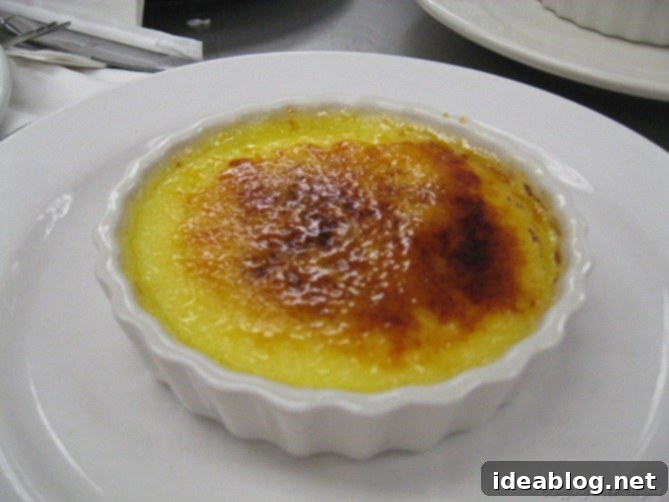
The Frenetic Pace of a Professional Kitchen
Our kitchen experience quickly transitioned from a state of calm, organized control to a frantic scramble in the final moments, barely managing to get everything plated and to the table. This dynamic, unfortunately, appears to be a recurring theme in our culinary training.
It’s truly the small, often overlooked details that consume the most time. Tasks like clarifying butter daily, meticulously peeling countless vegetables (yesterday it was close to 30 asparagus spears), and, of course, the arduous process of tourneeing, which was an adventure in itself, cumulatively add significant time to the preparation. Each seemingly minor step contributes to the overall complexity and time demand of a professional kitchen environment.
Complicating matters further, we were short two students yesterday, which meant I was teamed with two people instead of the usual one. While this might sound like a blessing (more hands!), at this stage in our training, each student is expected to perform a comprehensive range of tasks. Typically, each table is responsible for plating approximately 4-5 servings of each dish – usually two per student – intended to feed fellow pastry students, front-of-house staff, and ourselves. However, our table had to compensate for the absent students, making us responsible for plating a staggering NINE of everything.
While an additional four servings might not sound like a monumental increase, it severely impacted our already tight schedule. It demanded even more fish filleting, a greater quantity of those challenging tournéed potatoes, and a host of other intricate details, pushing our time management skills to their absolute limit.
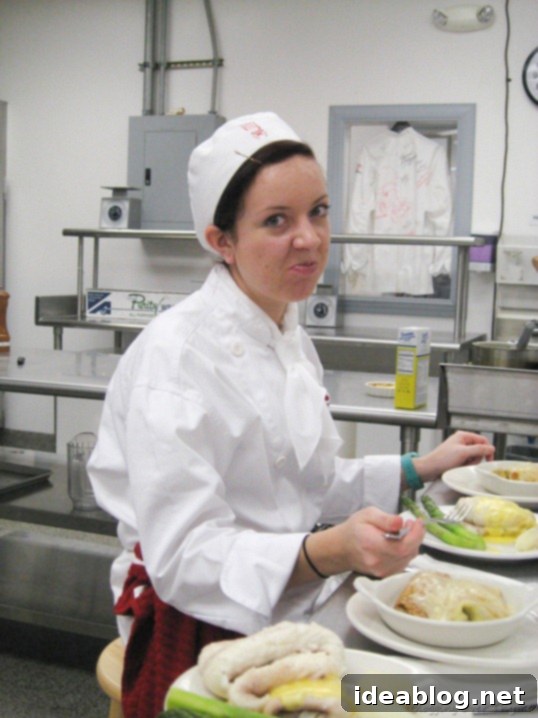
One of my partners for today, Hannah, who does not like fish!
Once again, we found ourselves behind schedule. By the time we finally sat down to eat, my appetite had largely vanished. The rapid shift from an adrenaline-fueled rush to a sudden expectation of relaxation and enjoyment of our food is incredibly jarring, especially when the time allotted for eating is minimal.
All I truly desired was to chug glass after glass of ice water to quench the intense thirst brought on by the kitchen’s heat and the day’s stress. Despite the constant race against the clock, I remain genuinely amazed by the sheer volume and complexity of what we manage to accomplish by the end of each day. And to think, this is apparently “nothing” compared to the challenges that lie ahead! Lordy, indeed.
Pastry vs. Savory: A Tale of Two Kitchens
Meanwhile, as we savory students were scurrying around “like chickens with our heads cut off,” the pastry students stood patiently, awaiting our finished dishes. They graciously offered gifts of homemade raspberry, vanilla, orange, and lemon macarons – a welcome reprieve and a stark contrast to our chaotic environment.
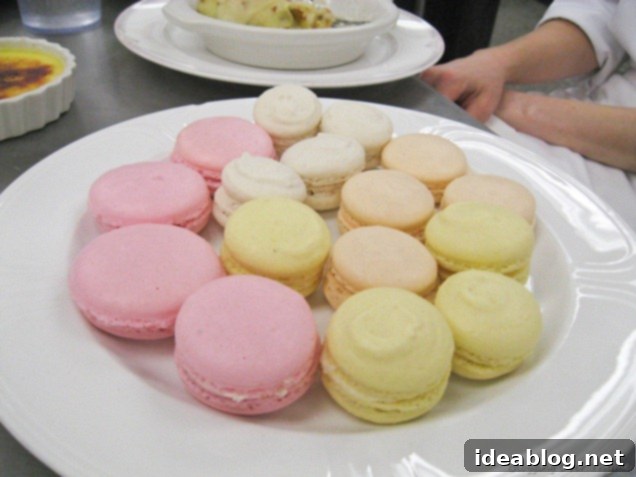
The pastry students always appear so much more serene and composed, which is quite amusing to observe. Curious about their daily pace, I inquired with one of them last week, and she shared a wonderfully enlightening analogy that I feel compelled to share with you all:
“You know that episode of Grey’s Anatomy, where they all go from surgery to dermatology and they are all sitting around not knowing what to do with all their newly freed up time???
Well…we’re dermatology, you are surgery”
Her analogy perfectly captures the contrasting rhythms of the culinary world. Savory cooking often feels like high-stakes surgery – intense, fast-paced, and requiring immediate adaptation. Pastry, by comparison, demands immense precision and patience, but its controlled environment can feel like a calmer, more methodical practice once the initial setup is complete. And with that, I’m off to prepare roast chicken for dinner, hoping it will be as delightful as the last time I made it!
